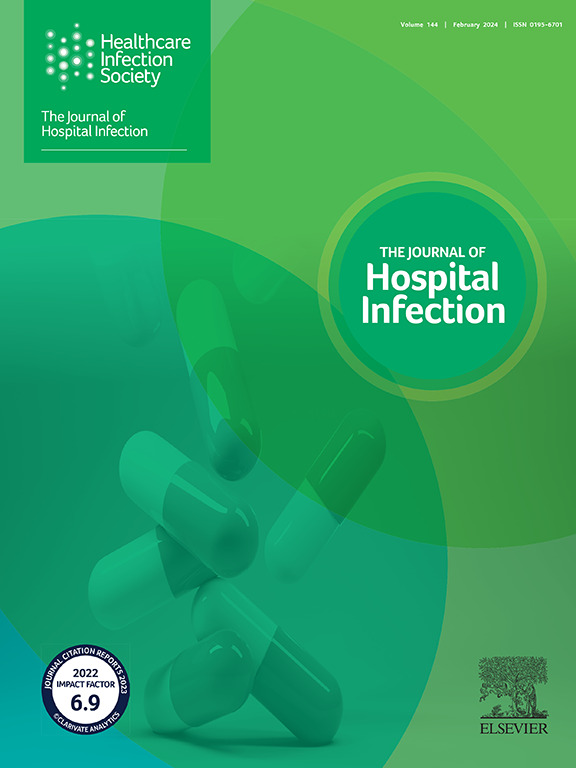臭氧水在唾液蛋白存在的情况下对 SARS-CoV-2 的消毒效果。
IF 3.9
3区 医学
Q1 INFECTIOUS DISEASES
引用次数: 0
摘要
背景:臭氧水可对环境表面的 SARS-CoV-2 有效消毒,但臭氧会被有机物质消耗,导致其效果减弱。唾液中的 SARS-CoV-2 可污染环境表面;因此,了解唾液中的有机物质对臭氧水消毒特性的影响至关重要:方法:将臭氧水与唾液中的有机物接触,并测量臭氧的残留浓度。将 SARS-CoV-2 暴露于唾液因子,测量臭氧水对病毒的灭活作用:结果:淀粉酶和粘蛋白消耗臭氧的方式与浓度有关。尿素不消耗臭氧。臭氧水似乎能在 30 秒内灭活 SARS-CoV-2 病毒。灭活的 SARS-CoV-2 的数量随着蛋白质浓度的增加而减少。1.5 毫克/升臭氧水对病毒的灭活作用强于 0.5 毫克/升臭氧水:这项研究表明,唾液淀粉酶和粘蛋白对臭氧的衰减与浓度有关,从而削弱了臭氧水对 SARS-CoV-2 的消毒作用。增加初始臭氧量可改善臭氧水对 SARS-CoV-2 的消毒效果。在控制病毒感染时应考虑臭氧消耗量。这些结果为臭氧水用于净化唾液中携带 SARS-CoV-2 的表面提供了基本信息。本文章由计算机程序翻译,如有差异,请以英文原文为准。
Disinfection effect of ozonated water on SARS-CoV-2 in the presence of salivary proteins
Background
Ozonated water is expected to be an effective disinfectant for SARS-CoV-2 present on environmental fomites; however, ozone is consumed by organic substances, resulting in attenuation of its effect. SARS-CoV-2 present in saliva can contaminate environmental surfaces; therefore, it is essential to understand the effect of organic substances in saliva on the disinfectant properties of ozonated water.
Aim
To assess organic factors in saliva and the extent to which they diminish the effect of ozonated water on SARS-CoV-2.
Methods
Ozonated water was exposed to salivary organic factors and residual ozone concentrations were measured. SARS-CoV-2 was exposed to a salivary factor and virus inactivation by ozonated water was measured.
Findings
Amylase and mucin consumed ozone in a concentration-dependent manner. Urea did not. Ozonated water appeared to inactivate SARS-CoV-2 within 30 s. The amount of inactivated SARS-CoV-2 decreased as the protein concentration increased. Virus inactivation was stronger by 1.5 mg/L ozonated water than by 0.5 mg/L ozonated water.
Conclusion
This study suggests that the salivary amylase and mucin decay ozone in a concentration-dependent manner, thereby attenuating the disinfection properties of ozonated water for SARS-CoV-2. An increase of the initial amount of ozone can ameliorate the disinfection effect of ozonated water on SARS-CoV-2. Ozone consumption should be taken into consideration for virus infection control. These results provide fundamental information about the effect of ozonated water when used to decontaminate surfaces harbouring SARS-CoV-2 in saliva.
求助全文
通过发布文献求助,成功后即可免费获取论文全文。
去求助
来源期刊

Journal of Hospital Infection
医学-传染病学
CiteScore
12.70
自引率
5.80%
发文量
271
审稿时长
19 days
期刊介绍:
The Journal of Hospital Infection is the editorially independent scientific publication of the Healthcare Infection Society. The aim of the Journal is to publish high quality research and information relating to infection prevention and control that is relevant to an international audience.
The Journal welcomes submissions that relate to all aspects of infection prevention and control in healthcare settings. This includes submissions that:
provide new insight into the epidemiology, surveillance, or prevention and control of healthcare-associated infections and antimicrobial resistance in healthcare settings;
provide new insight into cleaning, disinfection and decontamination;
provide new insight into the design of healthcare premises;
describe novel aspects of outbreaks of infection;
throw light on techniques for effective antimicrobial stewardship;
describe novel techniques (laboratory-based or point of care) for the detection of infection or antimicrobial resistance in the healthcare setting, particularly if these can be used to facilitate infection prevention and control;
improve understanding of the motivations of safe healthcare behaviour, or describe techniques for achieving behavioural and cultural change;
improve understanding of the use of IT systems in infection surveillance and prevention and control.
 求助内容:
求助内容: 应助结果提醒方式:
应助结果提醒方式:


